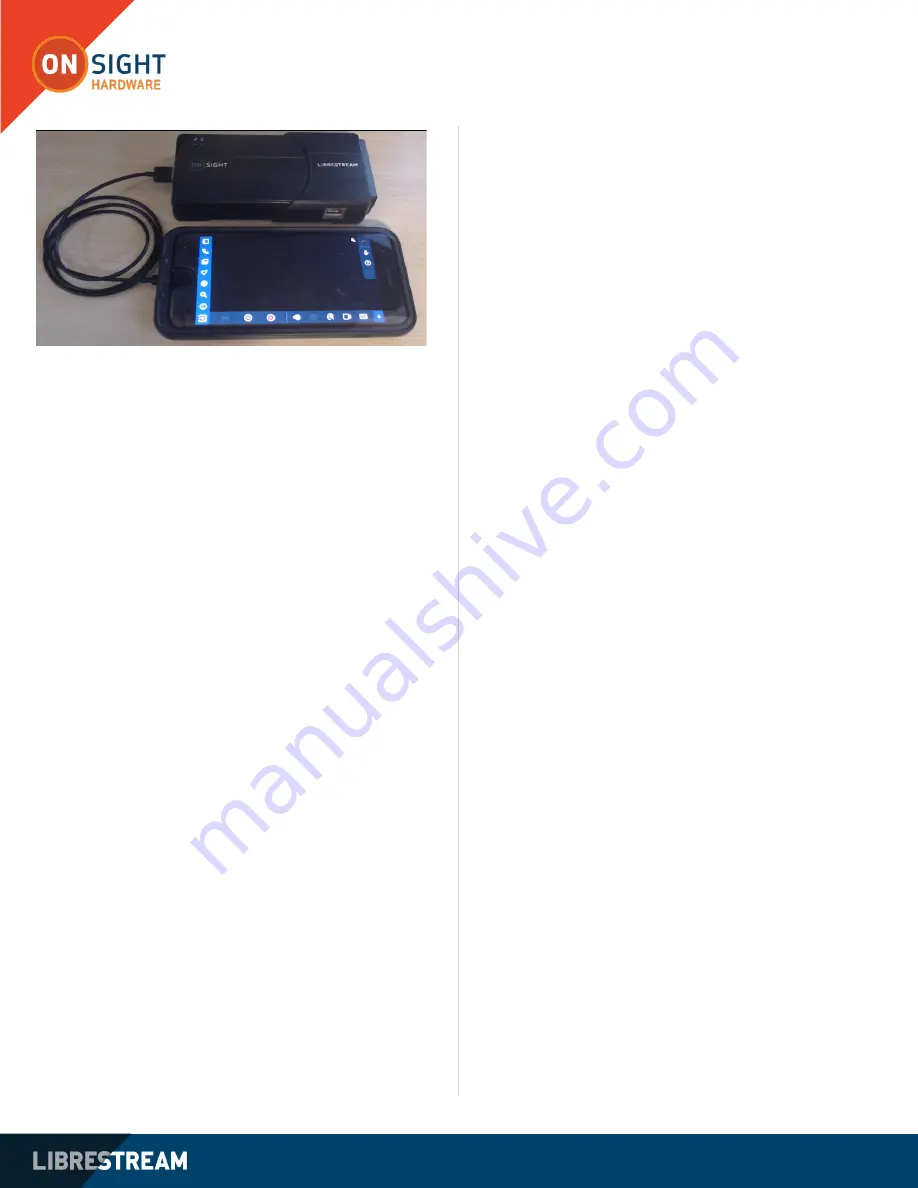
FOR MORE INFORMATION:
CALL 1.800.849.5507 | +1.204.487.0612
LIBRESTREAM.COM
Figure 4.4 Onsight Connect Application running on an iOS device
Whenever the Onsight Hub is disconnected from a smartphone,
Onsight Connect will automatically switch back to an internal
camera of the smartphone as the video source.
Onsight Hub Media Sources
Video Source Selection
Changing Stream Settings
Video Specification
Audio Source Selection
The Onsight Hub supports multiple video inputs which may be
simultaneously connected to the Onsight Hub. However, only
one video input will be active at a time. The order of video source
selection is as follows:
• HDMI (unprotected sources only, non-HDCP)
• USB video class devices (UVC USB Video Class v1.1 or higher
compliant)
• USB audio class devices (UAC for basic audio devices v1.0)
• VGA (up to XGA: 1024x768 @ 70 Hz)
• S-Video (NTSC and PAL)
• Composite Video using an S-Video Adapter (NTSC and PAL)
If the active source is removed from the Onsight Hub, it searches for
the next available source and selects it automatically.
The video source devices can be hot swapped. It is not necessary to
stop streaming before connecting or disconnecting any video source.
The Onsight user may select video stream settings using the Audio/
Video Settings screen. However the inputs available to the Onsight
Hub can vary in available resolutions, aspect ratio, and frame-rate.
For this reason, the Onsight Hub automatically adjusts the settings
to remain consistent with the capabilities of the active video source.
For example:
If the user selects D1 (720x480) at 30 frames per second (FPS)
and the Onsight Hub is connected to a USB camera that provides
a maximum of 640x480 @ 10 FPS, then the settings are adjusted
to 640x480, 10 FPS. If the user then unplugs the USB camera and
attaches an HDMI source of 1080p60, the Onsight Hub re-adjusts
the settings to 720x400, 30 FPS. The 720x400 resolution matches the
HDMI aspect ratio of 16:9 while not exceeding the original requested
frame size.
The Onsight Hub supports multiple video inputs which may be
simultaneously connected to the Onsight Hub. However, only
one video input will be active at a time. The order of video source
selection is as follows:
• HDMI (unprotected sources only, non-HDCP): up to 1080p30
• USB 2.0: USB Video Class (UVC) v1.1 or higher compliant devices
• USB 2.0: USB Audio Class (UAC) for basic audio devices v1.0
• VGA (up to XGA: 1024x768@70 Hz)
• S-Video: NTSC and PAL
• Composite Video (using an S-Video Adapter)
In addition to video, the Onsight Hub streams subject audio if it is
available. Subject audio is synchronized with the active video stream.
The availability of subject audio is summarized below for each media
input:
6
HDMI Media Input: HDMI supports both video and audio so subject
audio is available from HDMI sources that transmit audio.
USB Media Input: This input can simultaneously support video and
audio endpoints. Subject audio is available from USB cameras that
support it.
Note some USB audio devices have non-standard interfaces and
may not be compatible with the Onsight Hub.
S-Video and VGA Media Inputs: These video sources do not carry
audio signals and therefore do not support subject audio.
NOTE:
Any video source can be augmented with subject audio by
connecting a supported USB audio device to the Onsight Hub.
The USB media input captures audio when another media input
is selected as the video source. USB audio takes precedence and
replaces HDMI audio if HDMI is the selected source.



























